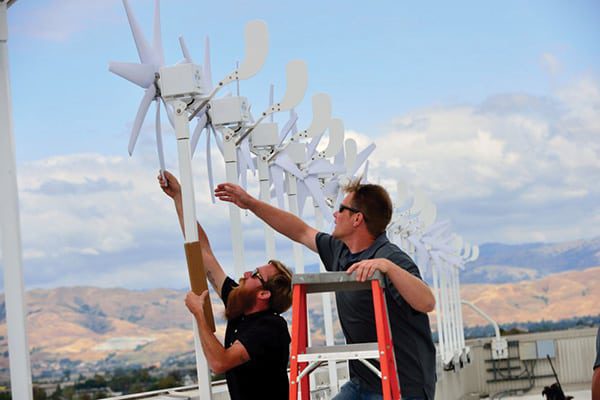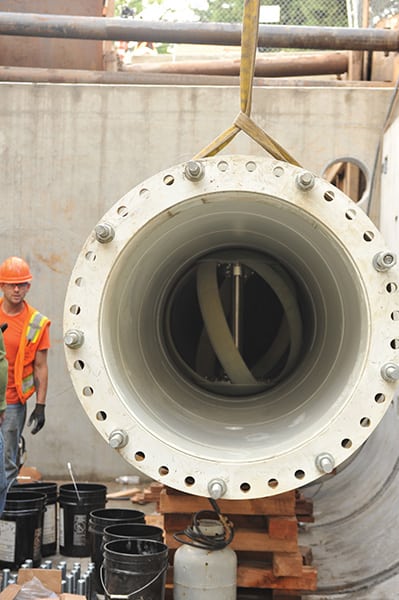Outside-the-Box Renewable Energy Microturbines
Rooftops with arrays of tiny wind-powered microturbines and hydro microturbines generating power as water flows through municipal drinking water systems or the outflow of municipal sewage treatment systems? They’re real.
For many in the electric power business, the term “microturbine” conjures up images of small, gas-fired machines, a fad a decade ago that never caught fire but that now is enjoying a bit of a comeback (see “Gas-Fired DG Showdown: Microturbines, Fuel Cells, or Reciprocating Engines?” in this issue). Similarly, say “wind turbine,” and the image that comes to mind is an enormous, slow-spinning, three-bladed device sitting on top of a large tower, most likely in a remote, rural location. “Hydro turbine” brings memories of big dams, enormous penstocks, and massive Pelton generators.
Intel Corp., the computer chip giant, and others, are turning those images on their heads. Intel is installing tiny wind turbines on the edge of the rooftop at its worldwide headquarters in Santa Clara, Calif. (Figure 1). The 58 small wind machines—about six feet tall and weighing 30 pounds each—should deliver about 65 kWh each, designed to power the conference center in the Robert Noyce Building (named for the company’s founder). That’s based on the local average wind speed of around 8 to 9 mph.
 |
| 1. Powered by wind. Intel has installed micro wind turbines on the roof of its California headquarters. Courtesy: Intel |
Micro Wind Power Generators
JLM Energy of Rocklin, Calif., is installing its “wind array turbine system,” using its Zefr wind turbines (rated at 240 W at 35 mph wind speeds), on the Intel building’s rooftop, where they will share the space with an array of solar photovoltaic panels. Marty Sedler, head of Intel’s infrastructure operations, told the San Jose Mercury News this summer that the wind array is designed as much as a proof-of-concept project as a commercial electric generator. “We are trying to understand how this type of technology integrates into Intel and where are the best locations around the world. We’ll share the data and share the information so other people can apply it to their own businesses and homes.”
Sedler told the newspaper that Intel’s rooftop wind array is “one of the largest we’ve identified anywhere.” He added, “One of the things Intel does that’s a little different from other companies is that all the projects we have done to date have been on our campuses. It’s not the answer. It’s one of the answers. The key is to get off the grid.”
Another concept that got some initial buzz was an elegant-looking wind microturbine array for large rooftops branded “Architectural Wind” by developer AeroVironment. The company’s website still touts this product as combining “the functional with the aesthetic to create the first modular and architecturally enhancing small wind turbine system.” However, the company told POWER that it decided to stop manufacturing the product “several years ago.”
Capturing Micro Hydro Power
Another outside-the-box microturbine application is under way in Salt Lake City. The city’s public utility department is planning to install hydro microturbines inside some of the pipes bringing water to the city from the surrounding mountains. The city plans to install two microturbines in a 36-inch water pipe. Public Utilities Director Jeff Niermeyer said, “Yes, we can do this project. It will pencil out.”
A Portland, Ore., startup, Lucid Energy has a pilot project capturing electricity with hydro microturbines from municipal water pipes in Riverside, Calif., and another operating in Portland (Figure 2). The Riverside project, funded with Department of Energy money, generates about 1,100 MWh/year, powering city street lights. Lucid has installed its technology in pipelines elsewhere, as well (see video here: http://www.lucidenergy.com/lucid-pipe/).
And in India, the Delhi city government has commissioned a project that generates power from the outflow of water from a municipal sewage treatment plant. The water falls nearly 5 meters from the plant, and the government says it can yield some 20 MWh/year with a hydro microturbine.
So, the next time you hear “microturbine,” think wind and hydro—as well as natural gas. ■
—Kennedy Maize is a long-time energy journalist and frequent contributor to POWER.
